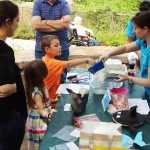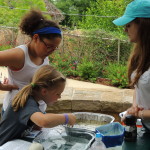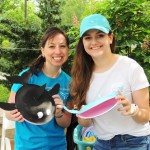 On Saturday, April 16, Azura celebrated Earth Day with kids and parents at the Dallas Arboretum and Botanical Garden. We partnered with the School of Natural Sciences & Mathematics at The University of Texas at Dallas to provide hands-on K-12 activities on geology, chemistry, marine life, space, physics, and more. For the second year, Azura’s scientists and volunteers brought the wonders of whales to the Dallas-Fort Worth area. We used our blubber and baleen experiments to show kids how whales stay warm in cold ocean waters and how they eat tiny prey like krill. Our newest activity, Build A Whale, was also a big hit with girls and boys of all ages.
On Saturday, April 16, Azura celebrated Earth Day with kids and parents at the Dallas Arboretum and Botanical Garden. We partnered with the School of Natural Sciences & Mathematics at The University of Texas at Dallas to provide hands-on K-12 activities on geology, chemistry, marine life, space, physics, and more. For the second year, Azura’s scientists and volunteers brought the wonders of whales to the Dallas-Fort Worth area. We used our blubber and baleen experiments to show kids how whales stay warm in cold ocean waters and how they eat tiny prey like krill. Our newest activity, Build A Whale, was also a big hit with girls and boys of all ages.
Activity #1 Blubber Gloves Experiment
 Blubber, the thick layer of fat beneath the skin, stores energy and keeps whales warm in cold waters. The kids got to feel what it’s like to take a dip in cold water without turning into a human popsicle. We used shortening, another insulating fat, stuffed between two plastic bags to serve as our glove of blubber. The kids placed one hand in the blubber glove and then placed both the gloved hand and the bare hand in a bowl of ice water to see which hand they could keep in the ice water longer. Using the blubber glove, the hand isn’t directly exposed to the water, so the fat takes the full brunt of the cold. The kids were amazed at how much the blubber glove kept their hands warm.
Blubber, the thick layer of fat beneath the skin, stores energy and keeps whales warm in cold waters. The kids got to feel what it’s like to take a dip in cold water without turning into a human popsicle. We used shortening, another insulating fat, stuffed between two plastic bags to serve as our glove of blubber. The kids placed one hand in the blubber glove and then placed both the gloved hand and the bare hand in a bowl of ice water to see which hand they could keep in the ice water longer. Using the blubber glove, the hand isn’t directly exposed to the water, so the fat takes the full brunt of the cold. The kids were amazed at how much the blubber glove kept their hands warm.
Activity #2 Baleen Experiment
 All whales are divided into toothed whales (odontocetes) and baleen whales (mysticetes). Odontocetes have jaws lined with pointed teeth that are used in hunting fish, squid, and other prey. Mysticetes lack teeth and use their baleen to filter small fish and tiny crustaceans from the water. Kids discovered how baleen whales use their baleen plates to filter food out of water. Baleen is like a combination of a comb and toothbrush. To simulate tiny fish and krill floating in water we sprinkled basil and pepper into a large bowl of water. The kids used a large comb, toothbrush, tongs, and a cheese grater to find out which one works best to capture more tiny fish (basil) and krill (pepper). The kids collected more fish with the comb and more krill with the toothbrush, showing that this combination definitely yields the most prey for baleen whales.
All whales are divided into toothed whales (odontocetes) and baleen whales (mysticetes). Odontocetes have jaws lined with pointed teeth that are used in hunting fish, squid, and other prey. Mysticetes lack teeth and use their baleen to filter small fish and tiny crustaceans from the water. Kids discovered how baleen whales use their baleen plates to filter food out of water. Baleen is like a combination of a comb and toothbrush. To simulate tiny fish and krill floating in water we sprinkled basil and pepper into a large bowl of water. The kids used a large comb, toothbrush, tongs, and a cheese grater to find out which one works best to capture more tiny fish (basil) and krill (pepper). The kids collected more fish with the comb and more krill with the toothbrush, showing that this combination definitely yields the most prey for baleen whales.
Activity #3 Build A Whale
 The kids learned about whale morphology with our Build A Whale activity. Whales vary in size and shape, and their fins and flukes vary greatly across some species. We used the blue whale and the killer whale as examples to demonstrate these differences. Using pre-made/painted whale pieces, the kids learned how to identify the pectoral flippers, dorsal fins, and tail flukes for each whale species and pieced together their choice of whale to take home with them. The blue whale’s dorsal fin is relatively tiny and positioned far back on the body. The flippers are long and bluntly pointed, and the tail flukes are as wide as a soccer net. In contrast, the killer whale’s pectoral flippers are rounded and paddlelike, and the dorsal fin is erect and can be as tall as 8 feet in some adult males. Their coloration is striking with black on the dorsal side and white on the ventral side. This pattern extends to the tail flukes so that they are white underneath and black on top. The kids also enjoyed coloring krill and fish to feed to their whales.
The kids learned about whale morphology with our Build A Whale activity. Whales vary in size and shape, and their fins and flukes vary greatly across some species. We used the blue whale and the killer whale as examples to demonstrate these differences. Using pre-made/painted whale pieces, the kids learned how to identify the pectoral flippers, dorsal fins, and tail flukes for each whale species and pieced together their choice of whale to take home with them. The blue whale’s dorsal fin is relatively tiny and positioned far back on the body. The flippers are long and bluntly pointed, and the tail flukes are as wide as a soccer net. In contrast, the killer whale’s pectoral flippers are rounded and paddlelike, and the dorsal fin is erect and can be as tall as 8 feet in some adult males. Their coloration is striking with black on the dorsal side and white on the ventral side. This pattern extends to the tail flukes so that they are white underneath and black on top. The kids also enjoyed coloring krill and fish to feed to their whales.
Special thanks to Alexandria Nestler (Azura intern and Collin College student), Jessica Rogmans (Azura volunteer), and Austin Nestler (photographer) for their hard work in making this event a success! We look forward to showing the Dallas-Fort Worth area a “whale of a good time” again next year!


